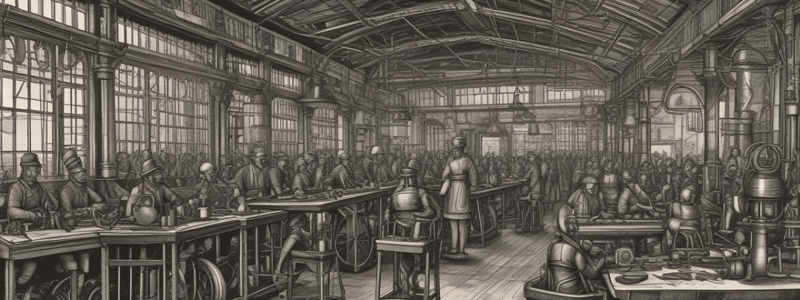Podcast
Questions and Answers
What was the primary goal of merchants and factory owners in New England in the 1790s?
What was the primary goal of merchants and factory owners in New England in the 1790s?
- To improve the putting-out system
- To steal technological knowledge from Britain (correct)
- To develop new machines to replace human labor
- To reduce labor costs
Who was contracted by a textile mill in Pawtucket, Rhode Island, to build a yarn-spinning machine and a carding machine?
Who was contracted by a textile mill in Pawtucket, Rhode Island, to build a yarn-spinning machine and a carding machine?
- Francis Cabot Lowell
- Paul Moody
- Samuel Slater (correct)
- A British mill owner
What was the significance of 1813 in the context of American industrial development?
What was the significance of 1813 in the context of American industrial development?
- The year Francis Cabot Lowell and Paul Moody re-created the powered loom (correct)
- The year the first textile mill was established in New England
- The year the putting-out system was introduced in America
- The year Samuel Slater built his first machine
How did Francis Cabot Lowell manage to smuggle England’s industrial know-how into New England?
How did Francis Cabot Lowell manage to smuggle England’s industrial know-how into New England?
What was the origin of the powered loom that Francis Cabot Lowell and Paul Moody re-created?
What was the origin of the powered loom that Francis Cabot Lowell and Paul Moody re-created?
Why did British customs officials search Francis Cabot Lowell's luggage?
Why did British customs officials search Francis Cabot Lowell's luggage?
Flashcards are hidden until you start studying
Study Notes
Industrial Revolution in New England
- In the 1790s, New England merchants started experimenting with machines to replace the putting-out system.
- The transition relied on the theft of British technological knowledge to build the machines needed.
- In 1789, a textile mill in Pawtucket, Rhode Island, hired 21-year-old British immigrant Samuel Slater to build a yarn-spinning machine and a carding machine.
- Slater had apprenticed in an English mill and successfully mimicked the English machinery.
Industrial Espionage
- The peak of American industrial espionage was in 1813 when Francis Cabot Lowell and Paul Moody recreated the powered loom used in Manchester, England's mills.
- Lowell spent two years in Britain observing and touring English mills, committing the powered loom's design to memory.
- He smuggled England's industrial know-how into New England, evading British customs officials' searches of his luggage.
Studying That Suits You
Use AI to generate personalized quizzes and flashcards to suit your learning preferences.




